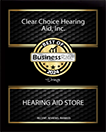
Have you utilized your ear trumpet lately? No? You don’t have one? Because that technology is hundreds of years old. Okay, I suppose that makes sense. Ear trumpets are a bit.. archaic.
The modern(ish) hearing aid, as it happens, was developed during the 1950s–the basic design, that is. And for some reason, that’s the hearing aid which has become identified in our collective consciousness. The problem is that a hearing aid made in the 1950s is just about as antiquated as an ear trumpet. To comprehend just how much better modern hearing aids are, we have to unshackle our imaginations.
Hearing Aids, Then And Now
It’s worthwhile to have some perspective about where hearing aids began in order to better perceive how sophisticated they have become. If we follow the history back far enough, you can probably find some form of hearing assistance device as far back as the 1500s (whether any of them ever really helped you improve your hearing is probably unlikely).
The first partially successful hearing assistance apparatus was most likely the ear trumpet. This device was shaped like, well, a long trumpet. The wide end pointed out and the small end was oriented into your ear. These, um, devices were not exactly high tech, but they did offer some measurable help.
The real revolution came when someone invited electricity to the party. The hearing aid that we are familiar with was really created in the 1950s. They were rather basic, using transistors and big, primitive batteries to effectively work. But these devices represent the start of a hearing aid that could easily be worn and hidden. Of course, modern hearing aids may share the same form and function as those early 1950s models–but their functionality goes far beyond what was conceivable 70 years ago.
Modern Capabilities of Hearing Aids
Put simply, modern hearing aids are technological masterpieces. And they keep getting better. In a few significant ways, modern hearing aids have been utilizing the digital technology of the later twentieth century. The first, and the most important way, is straight forward: power. Earlier models had batteries that had less power in a bigger space than their modern counterparts.
And a long list of innovative developments come with greater power:
- Speech recognition: For lots of hearing aid owners, the ultimate objective of these devices is to assist in communication. Separating and amplifying voices, then, is a primary feature of the software of many hearing aids–which can be pretty handy in a wide range of scenarios, from a packed restaurant to an echo-y meeting room.
- Construction: Modern hearing aids are normally made of high tech materials, so they feel more comfortable. These new materials allow hearing aids to be lighter and more heavy-duty simultaneously. And with the addition of long-lasting, rechargeable batteries, it’s easy to see how not only the inside–but also the outside–of hearing aids have advanced over the years.
- Selective amplification: Hearing loss normally manifests as loss of certain frequencies and wavelengths of sound. Perhaps low frequency sound gets lost (or vice versa). Modern hearing aids are far more efficient because they will amplify only the frequencies you have a hard time hearing.
- Bluetooth connectivity: Your hearing aids can now communicate with other devices using wireless Bluetooth technology. You will use this function every day. For instance, hearing aids in the past had a tough time dealing with telephone calls because users would hear considerable (and sometimes unpleasant) feedback. When you connect to your phone using Bluetooth, the transition is simple and communicating is effortless. You will also use Bluetooth functions to participate in a variety of other electronic activities. Because there isn’t any interference or feedback, it’s easier to watch TV, listen to music–you name it.
- Health monitoring: Contemporary hearing aids are also capable of incorporating sophisticated health monitoring software into their options. if you have a fall, for instance, some hearing aids can detect that. There are other functions that can keep you informed about your fitness goals like how many steps that you have taken.
Just as rotary phones no longer represent long-distance communication, the hearing aids of old no longer capture what these devices are. Hearing aids have changed a lot. And we should be excited because they’re a lot better than they used to be.










